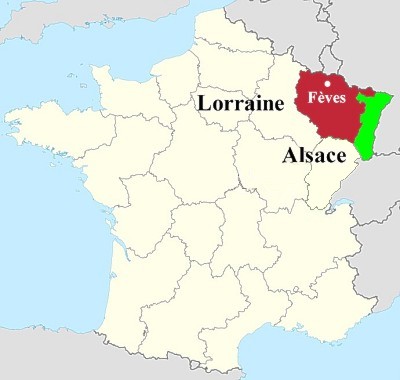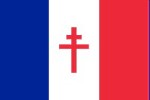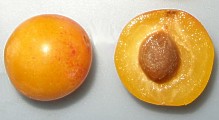So what did the Morganvillians know about their adopted village? They knew it was in the state of Lorraine, just as Morganville was in the state of Kansas. Today, Americans are most likely to associate Lorraine with the savory open-faced custard pie Quiche Lorraine, named after the region.
But to an American of Carson's time, Alsace was the word that would come to mind. This association was so tight that it prompted Todd to include the following in his July 26 letter:
I have just had a talk with a gentleman from Lorraine who informs me in no uncertain terms that Alsace Lorraine must never be used with a hyphen, but always referred to as two separate sections.
The French states of Alsace and Lorraine are similar to the U.S. states Montana and North Dakota. Both share a border with each other as well as a national border with another country. But unlike the former, Alsace and Lorraine were situated in an area often in upheaval.
Former French states of Alsace and Lorraine
The source of these problems in Lorraine has a long
history and continues to have an effect on the region. The name Lorraine is derived from Lothar, who was the grandson of
Charlemagne. Lothar was given the region as his share of his father's estate. The land is hilly and rolling. Like
Kansas, it is now a major producer of cattle and feed crops.
To the west, Lorraine rubs shoulders with people who are quintessentially French. To the north are the Belgians and
Luxembourgers, to the east is Germany and to the south is Alsace. Lorraine is a region sandwiched between peoples of
differing languages and cultures. It has adopted some of its neighbors' ways, yet remains unique.
Lorraine was fortunate to have large deposits of iron ore, which had been worked since Roman times. In 1704,
Jean-Martin Wendel came from Koblenz, Germany and acquired an old forge in Hayange about 18 miles north-northwest of
Metz. Wendel then began the exploitation of this important element coveted by every industrialized nation.
Fèves youngster Solange Parisot in traditional
Lorraine dress
Because of this valuable resource, France and Germany both
wanted the region. During the Franco-Prussian War in 1871, Germany took it from France. After WWI, it reverted to
France. When France was defeated at the start of World War II, Lorraine was annexed by Germany, only to be returned to France
after the war.
In the often-turbulent 250 years after Wendel's arrival, his family had the iron works taken from them several times,
only to later regain control. Through it all, the Wendel family managed to hold on to much of its accumulated wealth.
The Wendel family - de Wendel since 1727 - became strongly
devoted to Lorraine. They were often in the forefront of efforts to relieve the suffering of Lorraine's ordinary
citizens after one of the area's many upheavals. In the fall of 1944, General George Patton was a guest in the
de Wendel home.
But the region's ore is of a low grade and unprofitable in today's global market. So most related operations are now
shuttered, while the government tries to induce high-technology companies to locate in Lorraine.
The de Wendel chateau in 2015 as a restaurant and hotel
As for the de Wendel family in 2015, they are a major force in European financial circles.
Joan of Arc is Lorraine's most famous citizen, being
born in the southwest corner. Lorraine is divided into four regions. Fèves is in the Moselle department in the
northeast. The cross of Lorraine was the symbol used by the Free French forces during World
War II.
French flag with Lorraine cross
Although it is unlikely anyone in the two towns knew it, there
was already a fine thread that connected Lorraine with Morganville. The Marquis de Lafayette, from whom Todd's middle name had
descended, had been stationed at Metz when the American colonists took up arms. Thinking it an opportunity for a great adventure,
he purchased a ship and set sail from Bordeaux. Almost 175 years later, his namesake had facilitated Morganville finding a
friend just six miles from Lafayette's last French army post.
Two things the folks in Morganville did know about their adoptee prompted concern. One was that Lorraine was a Catholic
area, while Morganville was Protestant.
Another had to do with the mirabelle plum tree. While it is a native of Asia, it thrives in the combination of
Lorraine's climate and soil. While approximately 70 percent of the inch-diameter yellow fruit is used in making jams and
jellies, about 20 percent is made into plum brandy. This, along with the area being a traditional wine-making region,
bothered some of the people of "dry" Kansas.
But the doubters were won over when they learned the war had not spared a single Fèves cow, leaving 60 children with neither milk nor cereal to put it on.
Mirabelle plums
As for Carson, there were no signs she ever doubted they were doing the right thing. She showed McKee an entry from her diary.
Beyond one of the oceans waits the town we're going
to meet. The chance acquaintance - so interesting - can be one of those unroutine encounters which highlight all
family annals - like the few minutes conversation of my grandfather with an unknown lawyer in Springfield (who was
Abraham Lincoln) and the report to the family that he had met a great man. That conversation brought us west to
Kansas.
This chance acquaintance with our unknown town must be more than routine friendship. They must not think America is
dancing, while others plod. We must be sure if we send them bread, it does not taste like stone. Will our mayor
convey to theirs our earnest concern? Will their mayor grasp our innocence, forgive our limitations? We can only
share what we have.







